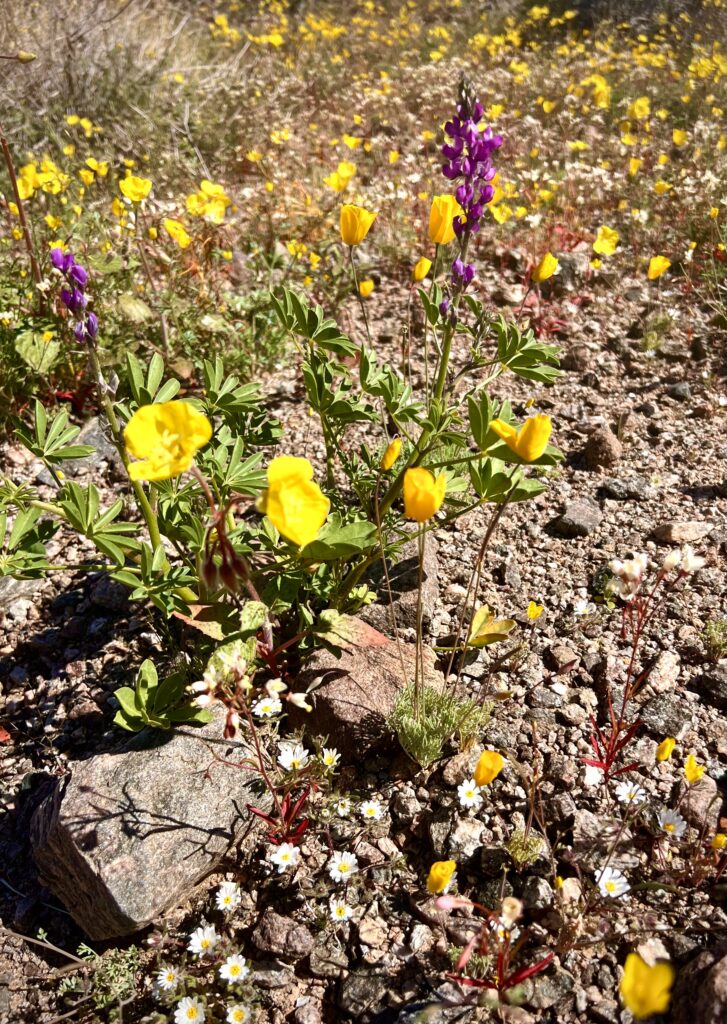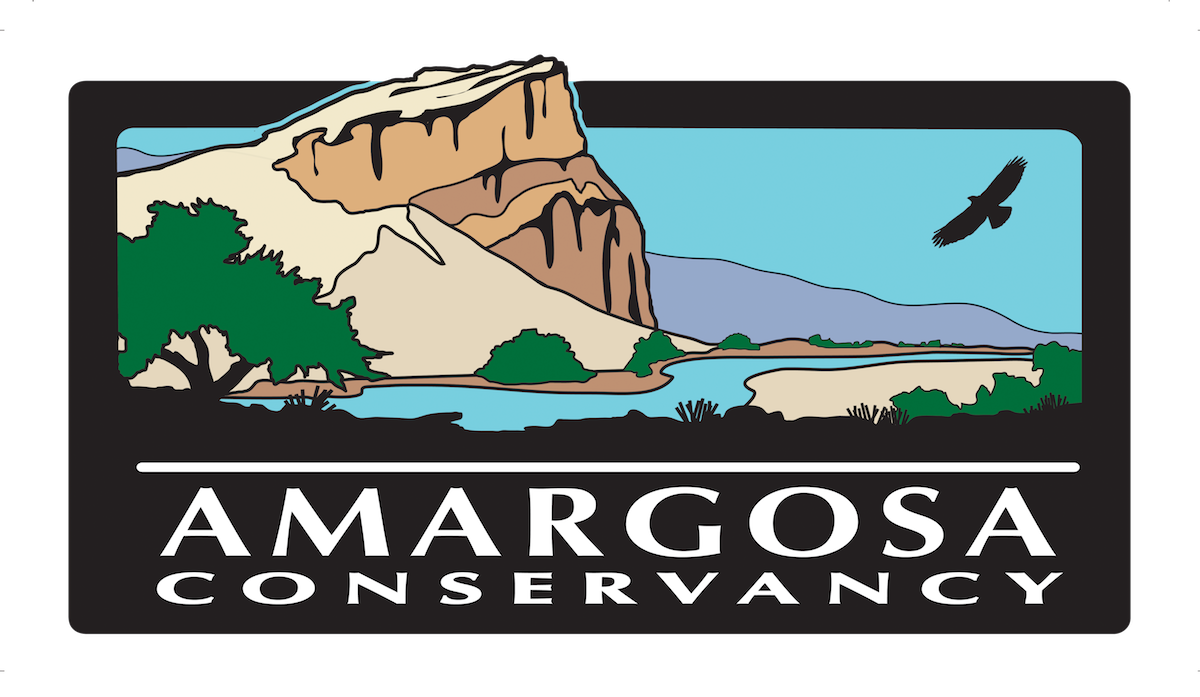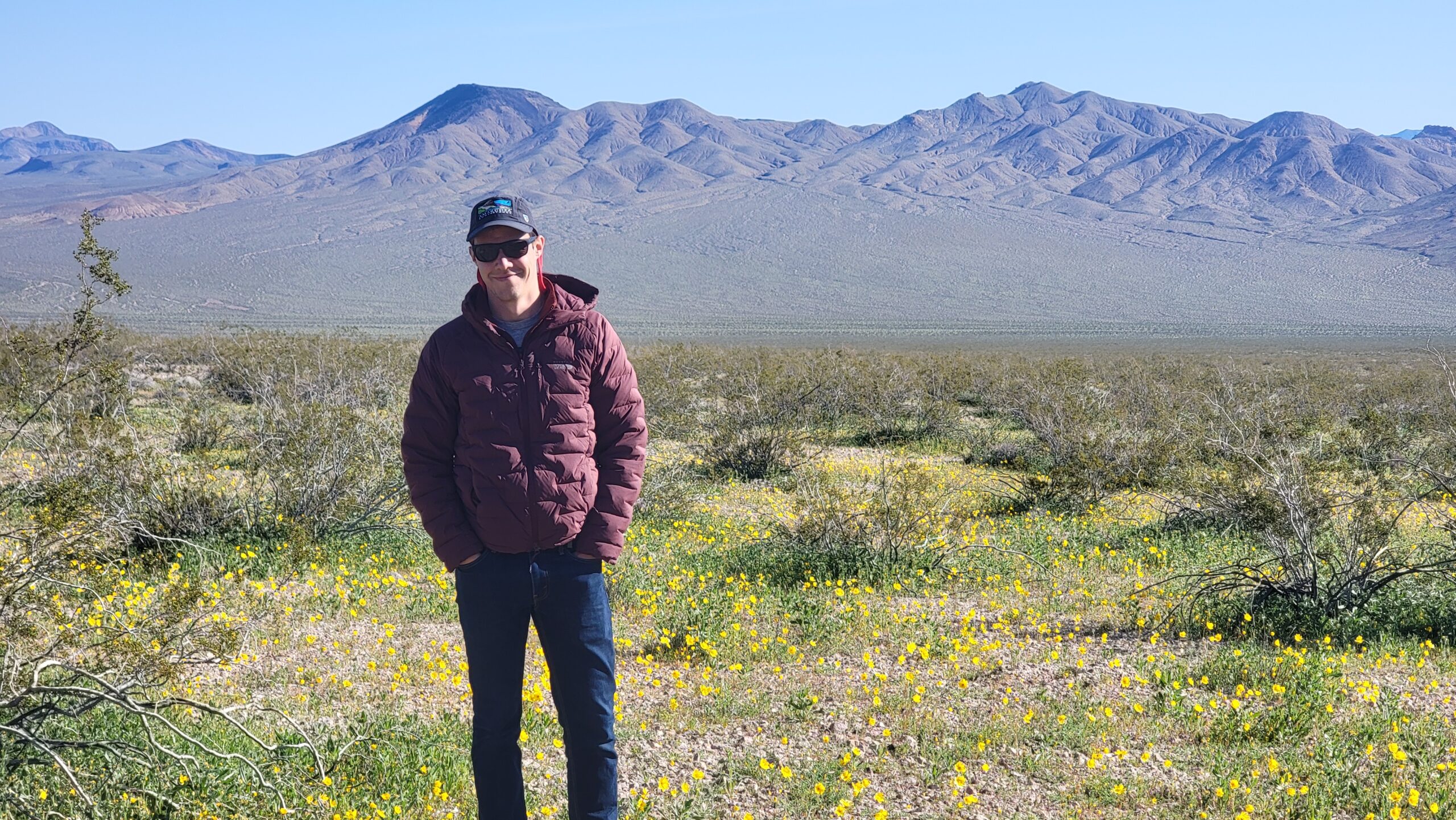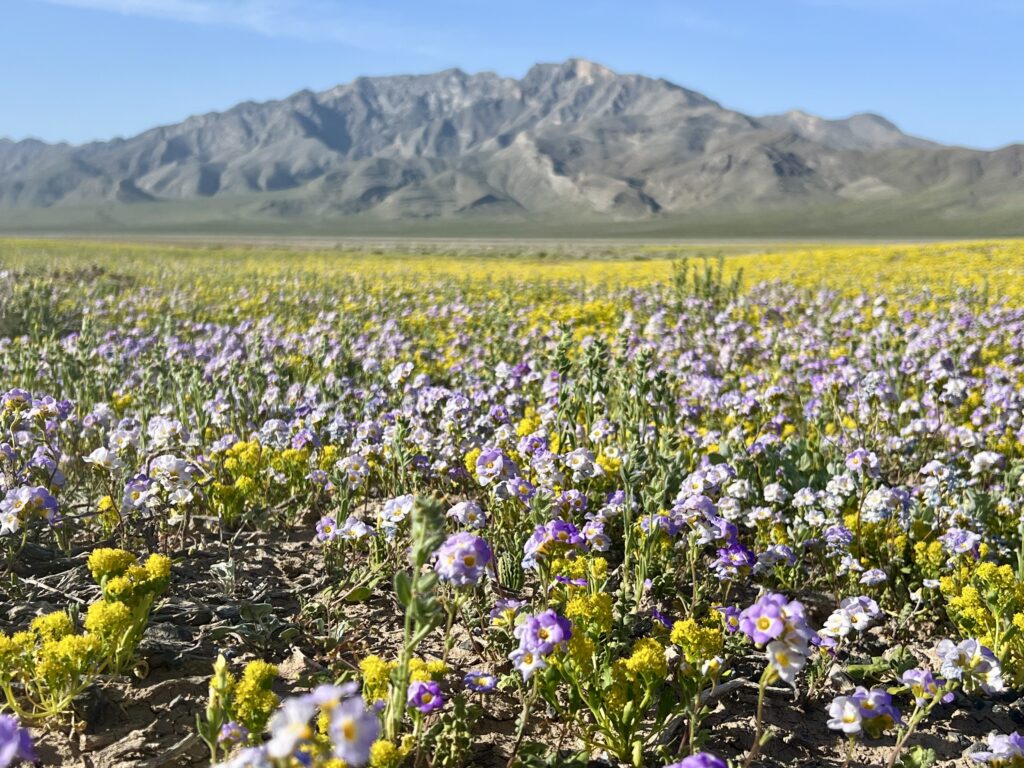by Mason Voehl, executive director
Where are these men? Asleep beneath their grounds:
And strangers, fond as they, their furrows plough.
Earth laughs in flowers, to see her boastful boys
Earth-proud, proud of the earth which is not theirs;
Who steer the plough, but cannot steer their feet
Clear of the grave.
Excerpt of “Hamatreya”, by Ralph Waldo Emerson
I was not really prepared for my first sight of the desert in bloom. Living in the Eastern Mojave, one learns to love the desert for what it so often is: a muted, subtle, xeric place that keeps its secrets close. The drought of the last few years has had a sedative effect on the landscape, forcing life in the desert to hunker down, to wait, and to be thrifty in its movements. Fortunately, the desert has through millenia attained that most difficult of virtues: patience
I started as the executive director of the Amargosa Conservancy at the end of 2021 when the Mojave was still in the throes of a brutal period in this prolonged drought. Born and raised a northerner, I didn’t know the desert could be other than it was when I moved to Nevada during those rainless months of the pandemic, and I fell in love with it anyways. But I knew the desert had different moods that I had yet to experience due to the overwhelming evidence hoarded by those that have seen what a modicum of rain can do to this place. As the new director, I inherited thousands of photos taken of the Amargosa Basin in bloom, mostly from the spring of 2016 in which (so I’m told) the Mojave bloomed big in the wake of prodigious rains and flooding in 2015. Rain fell in such quantities as to make the Amargosa River flow nearly half a mile wide in some places that year, wide and deep enough to navigate in a kayak. I know this because people I know did just that.
When I need an image that showcases the vibrance and vitality of this landscape, I pull from the file folders from that year and other bloom years. But like the rest of life in the desert, I have understood that to see this mood of the desert for myself would mean I too would have to learn patience. I would have to wait, maybe for a long time, for the rains to come.
And the rains did come. The summer monsoons of 2022 were powerful enough to resurrect ancient Lake Tecopa which once filled the Amargosa Basin thousands of years ago. Well, a shallow shadow of Lake Tecopa at least. Winter storms raked through the Death Valley region with more regularity, and by March I had begun to harbor a quiet hope that the mood of the desert might change this year. But blooms, I was told, are difficult to predict with much confidence. They happen in their own time, on schedules we don’t fully understand. Temperature is an important factor in producing a bloom as well, and as winter in the West clung on hard and cold, my quiet hope got even quieter.
Then a few weeks ago, I rounded a familiar hill on a road I’ve driven once or twice a week for the last 17 months, and there were flowers. Fields of flowers. Flowers as thick as carpet filling the wide basins. Tendrils of tender shoots, young and green and glowing in the morning sun coated the rocky slopes. It looked to me like an entirely different place than the one I had come to know. In an instant, I felt I better understood my friends, mentors and colleagues that have fought for the desert for decades. They fight because they have seen what I saw. This was the desert in bloom. This was the desert filled with laughter.
“Earth laughs in flowers” is to my knowledge the only line from Emerson’s “Hamatreya” that remains in modern circulation. It’s a pithy line that in four words provides a handy caption to include with a posted picture of flowers on Pinterest, or to print on a holiday card, or to hang as a placard on one’s wall to verbalize that boho aesthetic interior design scheme. On its face it appears a simple joyous declaration of nature’s inherent beauty. But as with virtually every line Emerson wrote, there is much more than meets the eye.
Walking along the road, fields of gold cup, Heliotrope phacelia, and perhaps a dozen other species all around me, I contemplated the likenesses of flowers and laughter. Laughter is an expression, usually of joy but sometimes of other emotions like surprise. Laughter is staccato, a series of sharp sounds punctuated by micro-sized silences. Laughter begins bright and high in pitch, and then gradually softens and descends. And laughter is short lived, ephemeral. Eternal laughter would be psychotic, frightening, and ultimately unenjoyable. Constant laughter would not really be laughter, or would erode the meaning and value of laughter as a concept and an experience.
And so in many ways, flowers are like laughter after all. Flowers are an expression of the land. Flowers are a signal that rain, sunlight, and an unseen multitude of complex forces have come together to produce something joyous, something surprising. Particularly in the Death Valley region where storms drop rains sporadically and changes in elevation are extreme, flowers are very much expressed as a staccato: the slope of one mountain may be exploding with flowers whereas the next remains utterly barren. When conditions are correct, flowerheads open wide to take full advantage of the chance to propagate, then gradually close when the sun moves on. And perhaps most importantly, flowers in the Mojave desert are an ephemeral phenomenon. They don’t last. Can’t last. They’re here, then gone again, sometimes for a long time, just as with laughter.
 But there is, I believe, another layer yet to investigate in Emerson’s meaning. In “Hamatreya,” the focus is not placed on the ephemerality of flowers, but on the ephemerality of humanity’s mastering of the natural world. The framing lines of the second stanza suggests as much: “Who are these men…who steer the plough, but cannot steer their feet clear of the grave?” By Emerson’s reckoning, perhaps it is not the ephemerality of the flowers that should so fascinate us, but the ephemerality of our own presence and force of will upon the landscape.
But there is, I believe, another layer yet to investigate in Emerson’s meaning. In “Hamatreya,” the focus is not placed on the ephemerality of flowers, but on the ephemerality of humanity’s mastering of the natural world. The framing lines of the second stanza suggests as much: “Who are these men…who steer the plough, but cannot steer their feet clear of the grave?” By Emerson’s reckoning, perhaps it is not the ephemerality of the flowers that should so fascinate us, but the ephemerality of our own presence and force of will upon the landscape.
Walking a road cut through a field of flowers, I began to wonder how long it would take for the flowers to eventually reclaim this corridor. A long time. Perhaps a very long time. But eventually, if the road was no longer traversed by people like me, someday it would be filled with flowers again. Though the season of wildflower bloom in the desert is so short lived, the desert operates on a deep cycle of time that we as individuals who get 80 years on the planet (if we’re lucky) can scarcely contemplate. That desert wildflowers bloom at all after years of intense drought is a testament to their success at patiently waiting for the right time to make their presence known, just as laughter is always an exercise in proper timing. Each season of bloom is a note on a much grander scale of staccato wherein a few weeks of flowers are the sharp punctuations surrounded by years or decades of silence. So long as the forces of rain, wind, and temperature stay within the bounds of good humor, the desert will continue to express its occasional and wonderful laughter into the deep future.
As I climbed back into my car, senses overwhelmed by the display around me, I realized that flowers attain a second variety of permanence: in us, in our experiences as witnesses of them. These halcyon days spent walking, these ephemeral moments filled with the desert’s laughter, they attain permanence in their impressions on their observers, in the memories of them that never leave us. Those that have experienced blooms tend to talk about them long after. Desert rats from every corner of the Mojave must have file folders like mine, filled with images that return them at least in part to that day and place when the desert was green, red, pink, gold, white, purple, and nearly every other color imaginable all at once. I’m grateful for the chance to fill my own file folder, to have the chance to relive these days when I need to the most: when I need a beautiful reminder of all I hope will remain long after I’m gone.


